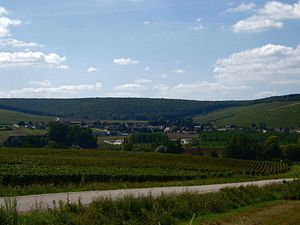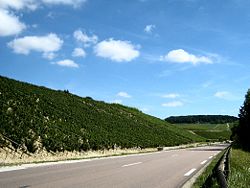Chablis (wine)
| Chablis (wine region) | |
 |
|
| Appellation type | Appellation d'origine contrôlée |
|---|---|
| Year established | 1938 |
| Country | France |
| Part of | Burgundy |
| Total area | 6834 |
| Size of planted vineyards | 4820 |
| Varietals produced | Chardonnay (Beaunois) |
The Chablis region is the northernmost wine district of the Burgundy region in France. The grapevines around the town of Chablis are almost all Chardonnay, making a dry white wine renowned for the purity of its aroma and taste.[1]
Contents |
Style
The northern location (48°N) means that Chablis wines have more acidity and less fruity flavours than Chardonnay wines grown in warmer climates, but their pure, minerally style has great elegance. They often have a "flinty" note, sometimes described as "goût de pierre à fusil" (gunflint) and sometimes as "steely".
In comparison to the white wines from the rest of Burgundy, Chablis has on average much less influence of oak. Much Chablis is completely unoaked, and vinified in steel tanks. The amount of barrel maturation, if any, is a stylistic choice which varies widely between Chablis producers. Many Grand Cru and some Premier Cru wines receive some maturation in oak barrels, but typically the time in barrel and the proportion of new barrels is much smaller than for white wines of Côte de Beaune.[1]
Chardonnay is known locally as "Beaunois", "the vine from Beaune".
History

The story of Chablis and its vineyards is of cycles of slow recoveries after violent setbacks, both human and viticultural.
It is likely that vines came to the region with the Romans, if not before. As elsewhere, the Dark Ages saw monasteries putting great effort into viticulture for communion wine, and the proximity of Auxerre meant that the market in Paris was readily accessible.
There are records in the mid-15th century of Chablis wine being shipped to England, Flanders and Picardy. But in February 1568 the town was razed by the Huguenots, and the region did not really recover until the 18th century. Then came the ravages of the Revolution, the Little Ice Age and Prussian invasions. Just as the vineyards were being built back up, they were hit first by mildew in 1880, and then by phylloxera.[2]
Again the region recovered, producing over 160,000 cases per year in the 1930s, but it took a heavy toll in World War II, and barely 5000 cases were produced in 1945. Production recovered to over 100,000 cases by 1949, but the vineyards were devastated by the late frosts of 1957 and 1961. Many were not replanted.
Geography
Chablis lies about 100 miles (160 km) north of Beaune, situated roughly halfway between Burgundy's heartland in Côte d'Or and Paris. It is therefore as near to Champagne as to the rest of Burgundy. Of France's wine-growing areas, only Champagne has a more northerly location. The region covers 15km x 20km across 27 communes, either side of the Serein river.
The soil is Kimmeridge Clay with outcrops of the chalk that extends from Sancerre up to the White Cliffs of Dover. The Grand Crus, the best vineyards, all lie in one small area just north of the town.
Appellation and classification

The main Chablis Appellation d'Origine Contrôlée was designated on 13th January 1938, but the junior appellation of Petit Chablis was not designated until 5th January 1944. In fact the vineyards are covered by four appellations at different levels of classification, reflecting all-important differences in soil and slope in this northerly region:
- Petit Chablis - (approx 1,550 hectares (3,800 acres)). A useful source of inexpensive wine from the least favoured sites on the hilltops and valley bottoms, this appellation has been in decline.
- Chablis - the main appellation covering 6,834 hectares (16,890 acres), of which either 4,400 hectares (11,000 acres) or 4,820 hectares (11,900 acres) are currently planted with vines. Covers the lower slopes of south-facing sites, and the middle slopes with less favorable aspect.
- Chablis Premier Cru - 750 hectares (1,900 acres), yield restricted to 50 hl/ha. Covers slopes on both sides of the River Serein, most facing either southwest or southeast. The main block lie southwest of the town, on the left bank of the valley, but the better ones are on the right bank by the Grand Crus. Several of the more famous ones absorbed less famous neighbours in the 1980s. In 1960 there was more Premier Cru wine produced than basic Chablis, although this has reversed as acreage of the latter has increased faster than the former.
- There are 79 Premier Cru vineyards, including Les Beauregards, Beauroy, Berdiot, Chaume de Talvat, Côte de Cuissy, Côte de Jouan, Côte de Léchet, Côte de Vaubarousse, Fourchaume, Les Fourneaux, Mont de Milieu, Montée de Tonnerre, Montmains, Vaillons, Vau de Vey, Vau Ligneau, Vaucoupin and Vosgros.
- Chablis Grand Cru - 100 hectares (250 acres), yield restricted to 45 hl/ha. These are the best sites, all in one small area on the right bank of the River Serein. The different Grand Crus apply to different aspects of three interlocking slopes just north of the town. The BIVB (but not the INAO) recognises an area within les Preuses and Vaudésir as a distinct Grand Cru, La Moutonne, but the seven Grand Cru vineyards generally recognised are (from northwest to southeast):[3]

-
- Bougros
- Les Preuses
- Vaudésir
- Grenouilles
- Valmur
- Les Clos
- Blanchot
"Chablis" in the New World
Until the 1970s, producers in the New World labelled their wines with names familiar to their customers. Hence the name "Chablis" would be applied to any dry white wine, regardless of where it came from or what grapes it was made from. Pressure from the French government and the rise of varietal labelling means that these semi-generic names are dying out.
References
- ↑ 1.0 1.1 "Chablis". Oxford Companion to Wine (Third Edition). (2006). Ed. Jancis Robinson. Oxford: Oxford University Press. 148-149. ISBN 0-19-860990-6.
- ↑ "Chablis, terroir of exception". Domaine Louis Moreau. Retrieved on 2007-04-29.
- ↑ Hanson, Anthony (2003). Burgundy. London. pp. 199.
See also

- French wine
- Burgundy wine
- List of Burgundy Grand Crus
External links
- Wines of Chablis Official web site
- Chablis Office of Tourism
- Map of Chablis showing the Grand Crus in red, Premier Crus in orange, standard Chablis in yellow and Petit Chablis in pale ochre.
|
|||||||||||||||||